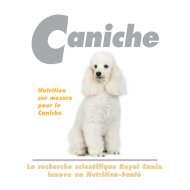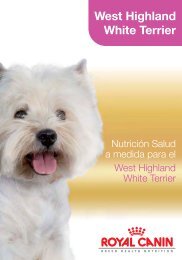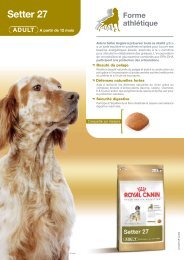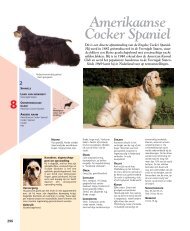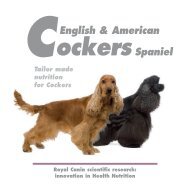Specific breed brochure - Breed Nutrition
Specific breed brochure - Breed Nutrition
Specific breed brochure - Breed Nutrition
Create successful ePaper yourself
Turn your PDF publications into a flip-book with our unique Google optimized e-Paper software.
<strong>Nutrition</strong> formulated<br />
to support joint health<br />
Around 40% of large dogs aged upwards of seven years old suffer from arthritis (Deeb and Wolf,<br />
1994), particularly those with dysplasia or osteochondritis and those that practised a physical activity<br />
at too young an age or too intensely, causing repeated microtraumas to joint cartilage.<br />
<strong>Nutrition</strong> is a way of providing substances that help maintain joint health. They can stimulate the<br />
regeneration of cartilage cells (glucosamine* and chondroitin*) and promote cartilage hydration.<br />
Glucosamine and chondroitin sulphate<br />
is a synergistic mix that helps support cartilage health<br />
Rottweiler 26 contains a high level (1200 mg per kg) of chondroitin sulphate and glucosamine,<br />
natural substances that help maintain the health of joints and cartilage (Johnston et al, 2001).<br />
These substances belong to the glycosaminoglycan family (GAGs), natural components of cartilage.<br />
GAGs facilitate the hydration of cartilage, which helps it fulfil its role as a shock absorber. They<br />
are also present in synovial fluid, helping lubricate the joints.<br />
glucosamine and chondroitin sulphate are given to dogs to help<br />
Structure of a joint cavity<br />
maintain joint health and mobility.<br />
1. Synovial fluid<br />
2. Synovial membrane<br />
3. Joint cartilage<br />
The joint is protected by a capsule lined with the synovial<br />
membrane, which secretes the fluid needed to nourish<br />
cartilage. After oral administration, glucosamine and<br />
chondroitin are concentrated in the synovial fluid.<br />
- Glucosamine is precursor of many components of cartilage.<br />
After oral administration it is concentrated in the joints<br />
(Davidson et al, 2000), where it stimulates the regeneration of<br />
cartilage, particularly by promoting the synthesis of collagen.<br />
(Braham et al, 2003).<br />
20



